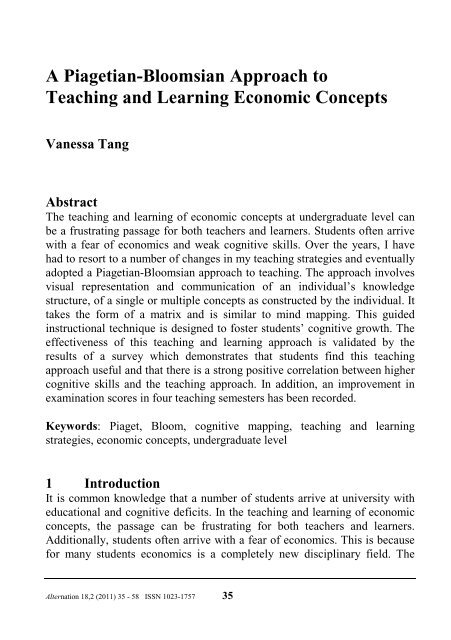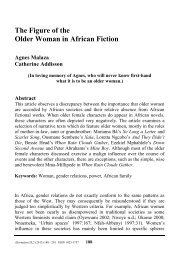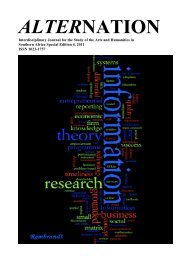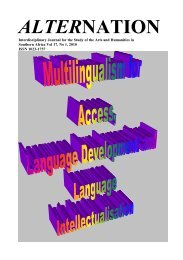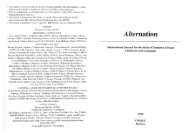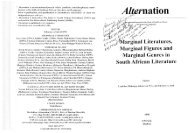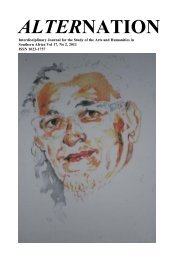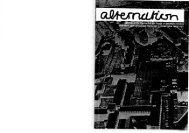A Piagetian-Bloomsian Approach to Teaching and Learning ...
A Piagetian-Bloomsian Approach to Teaching and Learning ...
A Piagetian-Bloomsian Approach to Teaching and Learning ...
You also want an ePaper? Increase the reach of your titles
YUMPU automatically turns print PDFs into web optimized ePapers that Google loves.
A <strong>Piagetian</strong>-<strong>Bloomsian</strong> <strong>Approach</strong> <strong>to</strong><br />
<strong>Teaching</strong> <strong>and</strong> <strong>Learning</strong> Economic Concepts<br />
Vanessa Tang<br />
Abstract<br />
The teaching <strong>and</strong> learning of economic concepts at undergraduate level can<br />
be a frustrating passage for both teachers <strong>and</strong> learners. Students often arrive<br />
with a fear of economics <strong>and</strong> weak cognitive skills. Over the years, I have<br />
had <strong>to</strong> resort <strong>to</strong> a number of changes in my teaching strategies <strong>and</strong> eventually<br />
adopted a <strong>Piagetian</strong>-<strong>Bloomsian</strong> approach <strong>to</strong> teaching. The approach involves<br />
visual representation <strong>and</strong> communication of an individual’s knowledge<br />
structure, of a single or multiple concepts as constructed by the individual. It<br />
takes the form of a matrix <strong>and</strong> is similar <strong>to</strong> mind mapping. This guided<br />
instructional technique is designed <strong>to</strong> foster students’ cognitive growth. The<br />
effectiveness of this teaching <strong>and</strong> learning approach is validated by the<br />
results of a survey which demonstrates that students find this teaching<br />
approach useful <strong>and</strong> that there is a strong positive correlation between higher<br />
cognitive skills <strong>and</strong> the teaching approach. In addition, an improvement in<br />
examination scores in four teaching semesters has been recorded.<br />
Keywords: Piaget, Bloom, cognitive mapping, teaching <strong>and</strong> learning<br />
strategies, economic concepts, undergraduate level<br />
1 Introduction<br />
It is common knowledge that a number of students arrive at university with<br />
educational <strong>and</strong> cognitive deficits. In the teaching <strong>and</strong> learning of economic<br />
concepts, the passage can be frustrating for both teachers <strong>and</strong> learners.<br />
Additionally, students often arrive with a fear of economics. This is because<br />
for many students economics is a completely new disciplinary field. The<br />
Alternation 18,2 (2011) 35 - 58 ISSN 1023-1757 35
Vanessa Tang<br />
subject includes the application of mathematical methods <strong>to</strong> represent<br />
economic theories – <strong>and</strong> many students do not enjoy mathematics. Also, as in<br />
the study of mathematics, the ability <strong>to</strong> apply logical <strong>and</strong> rational reasoning<br />
is a vital ingredient in the study of economics.<br />
Over the years, I have had <strong>to</strong> resort <strong>to</strong> a number of changes in<br />
teaching methods <strong>and</strong> eventually adopted a <strong>Piagetian</strong>-<strong>Bloomsian</strong> approach <strong>to</strong><br />
teaching <strong>and</strong> learning. At its core is the instructional applicability of Jean<br />
Piaget <strong>and</strong> Benjamin Bloom’s theories <strong>and</strong> educational principles in<br />
developing knowledge.<br />
Jean Piaget’s learning theory on cognitive <strong>and</strong> constructivist development<br />
has had a major influential impact on education. Whilst Piaget’s theory<br />
is geared <strong>to</strong>wards knowledge acquisition for children, his much inspired<br />
insights on the nature of children <strong>and</strong> their cognitive growth are useful <strong>and</strong><br />
can also be applied <strong>to</strong> adults in higher learning; for essentially what matters<br />
in cognitive growth ‘is not the age at which skills develop, but the sequence<br />
in which they develop <strong>and</strong> how they continue <strong>to</strong> evolve’ (Burman 2008:162).<br />
Echoing a similar viewpoint <strong>and</strong> influenced by Piaget’s ideas, is the work of<br />
Jerome Bruner <strong>and</strong> his influential book The Process of Education.<br />
Piaget’s assimilation-accommodation model of cognitive growth is<br />
insightful. His model allows us <strong>to</strong> reflect on the mental framework that<br />
cognitive development is an active process of acquisition <strong>and</strong> modification –<br />
a continuous process step-by-step of self-construction <strong>and</strong> discovery. For<br />
decades, <strong>to</strong> emphasise discovery learning, there has been, as Sweller (2009:<br />
127) points out, a large number of works that have used the <strong>Piagetian</strong> theory.<br />
What is the theoretical link between Piaget <strong>and</strong> Bloom? For Piaget,<br />
the mind of the learner exhibits cognitive dualism. But it is a duality of a<br />
particular type. For instance, at the University of KwaZulu-Natal (UKZN),<br />
the learner is thrust in<strong>to</strong> a situation where a novel concept is presented by the<br />
instruc<strong>to</strong>r. Piaget maintains that the learner has two cognitive characteristics.<br />
First the learner must assimilate that new concept in<strong>to</strong> her current set of<br />
cognate processes which are also two-fold: underst<strong>and</strong>ing <strong>and</strong> acting on the<br />
now shifting experiential underst<strong>and</strong>ing. These cognate changes are ‘plans’<br />
as it were, <strong>and</strong> the learner knows that the external reality can confront these<br />
plans or desires <strong>and</strong> the second response (as part of the duality) is that the<br />
learner must reconcile or accommodate this new concept with the external<br />
world. To be fair, this explanation of the underlying theory confounds Piaget<br />
36
A <strong>Piagetian</strong>-<strong>Bloomsian</strong> <strong>Approach</strong> <strong>to</strong> <strong>Teaching</strong> <strong>and</strong> <strong>Learning</strong> …<br />
<strong>and</strong> Vygotsky (Gillen 2000). The latter sees as fundamental, the need for an<br />
external facilita<strong>to</strong>r in this dual process. S<strong>and</strong>wiched in between the learner<br />
<strong>and</strong> the external reality is a conjuncture that an instruc<strong>to</strong>r helps the learner<br />
negotiate. This is where Bloom’s (1984) paper is explicit as <strong>to</strong> the role of the<br />
instruc<strong>to</strong>r or tu<strong>to</strong>r indicating that his roots are firmly in the Piaget camp via<br />
the influence of Vygotsky. Piaget’s <strong>and</strong> Bloom’s educational theories <strong>and</strong><br />
realist-constructivist view see learners as ‘the manufacturers of their own<br />
development’ (Flavell 1996:200). This is what inspired <strong>and</strong> changed my<br />
teaching approach.<br />
Thus, Piaget’s <strong>and</strong> Bloom’s educational theories <strong>and</strong> realistconstructivist<br />
views construct learners as ‘the manufacturers of their own<br />
development’ (Flavell 1996:200). This principle has inspired <strong>and</strong> changed<br />
my teaching approach which is now within a connectionist framework.<br />
This paper takes a cognitive-constructivist approach <strong>to</strong> teaching <strong>and</strong><br />
learning <strong>and</strong> proposes a teaching strategy that is designed <strong>to</strong> engage students<br />
<strong>and</strong> develop their analytical <strong>and</strong> creative skills as they identify, explore <strong>and</strong><br />
link key concepts. The effectiveness of this teaching <strong>and</strong> learning approach is<br />
verified by the results of a survey. The overall results show that students find<br />
this teaching approach useful <strong>and</strong> there is also a strong positive correlation<br />
between higher cognitive skills <strong>and</strong> usefulness of the teaching approach. In<br />
addition, there has been an improvement in examination scores in four<br />
teaching semesters.<br />
The paper is divided in<strong>to</strong> seven sections. The first section sets the<br />
background. The second discusses the adapted theoretical framework of the<br />
<strong>Piagetian</strong>-<strong>Bloomsian</strong> approach. The third section describes the <strong>Piagetian</strong>-<br />
<strong>Bloomsian</strong> technique <strong>and</strong> then explores its potential usage as an instructional<br />
<strong>to</strong>ol. The fourth section addresses the educational objectives of the <strong>Piagetian</strong>-<br />
<strong>Bloomsian</strong> approach <strong>and</strong> offers a practical discussion of its applications. The<br />
fifth section provides the empirical framework of this study. The sixth<br />
section highlights the hypotheses of the study <strong>and</strong> discusses the survey<br />
methodology <strong>and</strong> results. Concluding remarks are made in the last section.<br />
2 Theoretical Base<br />
Good teaching involves getting students <strong>to</strong> use higher cognitive level<br />
processes (Biggs 1989) <strong>and</strong> involves the creation of problem solving<br />
37
Vanessa Tang<br />
scenarios for learners that follows on<strong>to</strong> one another with some guidance <strong>and</strong><br />
freedom (Piaget in Evans 1973:53). To be able <strong>to</strong> discuss with others what<br />
one is learning <strong>and</strong> learning by doing translates in<strong>to</strong> better underst<strong>and</strong>ing<br />
(Piaget 1926). The theoretical considerations of the proposed <strong>Piagetian</strong>-<br />
<strong>Bloomsian</strong> approach supports <strong>and</strong> draws on the realist-constructivist views of<br />
both Piaget <strong>and</strong> Bloom <strong>and</strong> visually, is closely related <strong>to</strong> various graphical<br />
organisers that are used in a variety of disciplines. Most graphic organisers<br />
such as mind mapping are based on a cognitive approach. This section<br />
explores the conceptual framework of the <strong>Piagetian</strong>-<strong>Bloomsian</strong> approach.<br />
The theoretical base of Bloom (1984) is relatively easy <strong>to</strong> discern.<br />
While the analysis is mostly empirical the categories that are set up <strong>to</strong><br />
evaluate improved performance have an implicit link <strong>to</strong> the theory of<br />
learning. These categories are first instruction in a class with a teacher <strong>and</strong><br />
the occasional test, second, the class now with formative testing <strong>and</strong><br />
feedback from the instruc<strong>to</strong>r <strong>and</strong> peers, <strong>and</strong> finally the one-on-one tu<strong>to</strong>ring<br />
approach. Abstracting from Piaget, this structure is directly from Vygotsky<br />
<strong>and</strong> Bloom’s contribution is <strong>to</strong> realise the final category is prohibitively<br />
expensive <strong>and</strong> his second category is a ‘middle way’ without losing <strong>to</strong>o much<br />
by way of affecting learning. Whether this compromise is entirely effective<br />
has <strong>to</strong> be established. Slavin (1987) shows that it is not. However the study<br />
does have a short-term bias (Bloom 1987). Berger (2004) is closer <strong>to</strong> the type<br />
of Piaget, Vygotsky <strong>and</strong> Bloom study we conduct here.<br />
2.1 A Cognitive Conceptual Framework<br />
The term ‘cognitive’ gives a broader <strong>and</strong> deeper theoretical perspective on<br />
the idea of how mapping techniques can improve the quality of teaching.<br />
His<strong>to</strong>rically, the term ‘cognitive mapping’ was supposedly first linked <strong>to</strong> the<br />
experimental investigations of Edward Tolman (1948). He referred <strong>to</strong><br />
cognitive mapping as mental constructions of the spatial layout of the<br />
environment, indicating the location of different features of the environment<br />
<strong>and</strong> the paths linked <strong>to</strong> them. Others such as Jonassen, Beissner <strong>and</strong> Yacci<br />
(1993) have referred <strong>to</strong> cognitive mapping as two-dimensional or three<br />
dimensional diagrams that represent the structure <strong>and</strong> relationships between<br />
ideas.<br />
Piaget’s assimilation-accommodation model of cognitive growth can<br />
38
A <strong>Piagetian</strong>-<strong>Bloomsian</strong> <strong>Approach</strong> <strong>to</strong> <strong>Teaching</strong> <strong>and</strong> <strong>Learning</strong> …<br />
be used as a basis for cognitive maps <strong>and</strong> <strong>to</strong> the end this active instructional<br />
strategy results in conceptual change since economic concepts are now better<br />
<strong>and</strong> more accurately reasoned <strong>and</strong> represented – satisfying theoretical views<br />
regarding knowledge coherence.<br />
According <strong>to</strong> ongoing research in education, cognitive maps are<br />
useful <strong>to</strong>ols for:<br />
� Problem solving (Buzan & Buzan 1993)<br />
� Creative thinking (Buzan 2000);<br />
� Representing, assessing, conveying, <strong>and</strong> acquiring structural<br />
knowledge (Jonassen, Beissner, & Yacci 1993); <strong>and</strong><br />
� Identifying, exploring, underst<strong>and</strong>ing <strong>and</strong> linking key concepts<br />
(White & Guns<strong>to</strong>ne 1992; Novak & Canas 2008)<br />
The aforementioned assumptions that cognitive mapping can be helpful <strong>and</strong><br />
increases learning effectiveness suggest that cognitive mapping techniques<br />
could play an important role in teaching. The sine qua non of most current<br />
cognitive maps is that of Bloom’s taxonomy. Usually put in a pyramid<br />
structure (although it need not be, see for instance, Sam Weinberg <strong>and</strong> Jack<br />
Schneider 2010), the elements of any attempt <strong>to</strong> come <strong>to</strong> grips with a novel<br />
idea, helped by an instruc<strong>to</strong>r, must include knowledge, comprehension,<br />
application, analysis, synthesis <strong>and</strong> evaluation. All of these elements include<br />
the four areas above. Bloom’s influence is clearly evident in these<br />
expressions of cognitive maps.<br />
2.2 A Constructivist Conceptual Framework<br />
Universities are said <strong>to</strong> be among the most promising c<strong>and</strong>idates for<br />
encouraging constructivist-learning environments (Jonassen, Mayes, &<br />
McAleese 1993). Likewise, Piaget <strong>and</strong> Bloom recognise the importance of<br />
students active participation. By implication, the educational principle is<br />
based on a hardly debatable psychological fact that; ‘intelligence proceeds<br />
from action’ (Piaget 1950:35). Cognitive mapping as a cognitive <strong>to</strong>ol is<br />
constructivistic because it actively engages learners in the creation of<br />
knowledge that reflects their comprehension <strong>and</strong> conception of the<br />
information (Kommers & Lanzing 1997).<br />
39
Vanessa Tang<br />
In higher learning at UKZN, all courses, now termed modules,<br />
require a module template. These templates set out the goals <strong>and</strong> objectives<br />
of a course. In addition, the template also requires some framework for<br />
establishing how these goals or objectives are met. No matter one’s<br />
assessment of this structure, it is easy <strong>to</strong> discern that the template structure<br />
has antecedents in the taxonomies of Bloom, which, we have argued above,<br />
have strong theoretical links <strong>to</strong> Piaget <strong>and</strong> Vygotsky. Thus at UKZN, we<br />
have the practical expression of well-established (but not without its<br />
detrac<strong>to</strong>rs) educational <strong>and</strong> cognitive theory. Arising from this practical<br />
application of Bloom, it is thus of some interest <strong>to</strong> determine if<br />
the theoretical ideas, on which these practical ideas are based, can be tested<br />
in the classroom context at UKZN. Also given that online instruction, using<br />
the so called Web 2.0 applications is now commonplace, the taxonomy of<br />
Bloom is undergoing renewed interest. See, for example the Schoenfeld-<br />
Tacher, McConnell Graham (2001) study where computer aided instruction<br />
combined with Bloom’s taxonomy provided measurable benefits <strong>to</strong> learners.<br />
3 The <strong>Piagetian</strong>-<strong>Bloomsian</strong> <strong>Approach</strong><br />
In this section, a description of the <strong>Piagetian</strong>-<strong>Bloomsian</strong> technique is<br />
provided <strong>and</strong> its potential usage as an instructional <strong>to</strong>ol is explored.<br />
3.1 What is the <strong>Piagetian</strong>-<strong>Bloomsian</strong> Technique?<br />
The <strong>Piagetian</strong>-<strong>Bloomsian</strong> instructional technique is designed <strong>to</strong> offer a<br />
conceptual change regarding knowledge coherence <strong>and</strong> foster student’s<br />
cognitive growth. The <strong>Piagetian</strong>-<strong>Bloomsian</strong> technique is a visual-guided<br />
representation <strong>and</strong> communication of an individual’s knowledge structure of<br />
a single or multiple concepts as constructed by the individual. It takes the<br />
form of a matrix <strong>and</strong> is similar <strong>to</strong> mind mapping.<br />
This technique is aimed at stimulating learners <strong>and</strong> creates a more<br />
effective teaching <strong>and</strong> learning environment. The matrix system of learning<br />
has five essential characteristics similar <strong>to</strong> mind mapping:<br />
1. The main <strong>to</strong>pic is identified.<br />
2. The key themes relating <strong>to</strong> the main <strong>to</strong>pic are then identified.<br />
40
A <strong>Piagetian</strong>-<strong>Bloomsian</strong> <strong>Approach</strong> <strong>to</strong> <strong>Teaching</strong> <strong>and</strong> <strong>Learning</strong> …<br />
3. Colours are used <strong>to</strong> highlight the main <strong>to</strong>pic <strong>and</strong> the key themes.<br />
4. Key themes are explored-linked <strong>and</strong> can comprise key words,<br />
definitions, questions, codes, symbols, diagrams or tables.<br />
5. Sub themes are explored-linked <strong>and</strong> can comprise key words,<br />
definitions, questions, codes, symbols, diagrams or tables.<br />
For a visual distinction between the mind map <strong>and</strong> the <strong>Piagetian</strong>-<strong>Bloomsian</strong><br />
approach I refer readers <strong>to</strong> Figure 1 <strong>and</strong> Figure 2 in appendix 1. Technically,<br />
it aims <strong>to</strong> visually provide a one-page recording of knowledge showing<br />
relationships or connections among multiple <strong>to</strong>pics/concepts <strong>and</strong> also<br />
allowing one <strong>to</strong> draw conclusions. As a visual representation of ideas or<br />
knowledge it can help learners <strong>to</strong> think or review a subject in a more<br />
structured holistic sense.<br />
3.2 Uses of the <strong>Piagetian</strong>-<strong>Bloomsian</strong> Technique<br />
Learners need opportunities <strong>to</strong> discuss their tentative underst<strong>and</strong>ing with<br />
others <strong>and</strong> build conceptual connections <strong>to</strong> their existing knowledge. Piaget<br />
(1926), Laurillard (1993), Jonassen et al. (1993) <strong>and</strong> Brown (1997) argue<br />
that the learner, through active participation in both arriving at, <strong>and</strong><br />
articulating their personal underst<strong>and</strong>ings of new ideas <strong>and</strong> concepts,<br />
constructs knowledge. Similarly, echoing this viewpoint is the Bloom’s<br />
taxonomy <strong>and</strong> its learning expectations.<br />
As an instructional <strong>to</strong>ol, the <strong>Piagetian</strong>-<strong>Bloomsian</strong> technique can be<br />
used by teachers in testing, reviewing <strong>and</strong> stimulating thoughts in a particular<br />
unit of a course. A very recent paper in this regard, is that of Lundquist <strong>and</strong><br />
Hill (2009) who still find use for Bloom’s methods in English language<br />
instruction. In this case, Bloom’s approach helps <strong>to</strong> align class test results<br />
with university st<strong>and</strong>ards <strong>and</strong> benchmarks. This reinforces our earlier<br />
impetus for examining Bloom as UKZN’s quality control processes rise out<br />
of the underlying theory.<br />
The <strong>Piagetian</strong>-<strong>Bloomsian</strong> representation can be a useful<br />
structure/framework for testing, reviewing <strong>and</strong> stimulating thoughts in a<br />
particular unit of a course. It aims <strong>to</strong> create a way for the teacher <strong>and</strong> the<br />
learner <strong>to</strong> see interconnections <strong>and</strong> potential relationships between <strong>to</strong>pics <strong>and</strong><br />
concepts in the course, thus assisting users <strong>to</strong> see how best <strong>to</strong> present the<br />
41
Vanessa Tang<br />
connection between the concepts in the course. This, allows learners <strong>to</strong><br />
present their knowledge in a more logical <strong>and</strong> coherent form with the<br />
freedom <strong>to</strong> discuss <strong>and</strong> confer with peers.<br />
This teaching approach when used correctly can help reduce the need<br />
for student memorisation <strong>and</strong> accelerate meaningful cognitive development.<br />
This <strong>Piagetian</strong>-<strong>Bloomsian</strong> technique can further be used by the instruc<strong>to</strong>r as<br />
the basis for the organisation of a lecture <strong>and</strong> <strong>to</strong> generate questions so as <strong>to</strong><br />
stimulate ‘dormant’ thoughts. I have often taught using this approach but<br />
found that this method of teaching works generally better for smaller groups.<br />
Also in my experience, for a better response <strong>and</strong> more meaningful cognitive<br />
processing if the ‘skele<strong>to</strong>n’ concept maps are made available in advance as<br />
lecture notes, it gives the learners a preview of what they will be working on<br />
<strong>and</strong> also helps <strong>to</strong> ease the instruction.<br />
4 Objectives <strong>and</strong> Application of the <strong>Piagetian</strong>-<strong>Bloomsian</strong><br />
<strong>Approach</strong><br />
To provide a sense of realism <strong>and</strong> <strong>to</strong> be able <strong>to</strong> gauge the achievement effects<br />
of this <strong>Piagetian</strong>-<strong>Bloomsian</strong> instructional approach, the paper uses Bloom’s<br />
classic taxonomy of educational objectives (started in 1948 <strong>and</strong> completed in<br />
1956). The first part of this section of the paper begins by addressing the<br />
desired <strong>and</strong> reasonable educational objectives. The second part then provides<br />
a description as <strong>to</strong> how students can be introduced <strong>to</strong> this teaching method<br />
<strong>and</strong> in the process targets the cognitive skills desired in the teaching of<br />
economics.<br />
4.1 Objectives<br />
Whilst the paper chooses <strong>to</strong> follow Bloom’s classic Taxonomy, it does<br />
acknowledge that the twenty-first century has brought us a revision (as<br />
illustrated in Figure 1 below) of Benjamin Bloom’s work on the taxonomy of<br />
the cognitive domain (Anderson & Krathwohl 2001). Technically, it is<br />
worthwhile pointing out that in the revised taxonomy, whilst the hierarchical<br />
systems have changed; their instructional objectives have remained<br />
essentially the same. For instance, Bloom’s ‘synthesis’ is essentially<br />
addressing the revised higher cognitive level of ‘creation’ – the classic<br />
42
A <strong>Piagetian</strong>-<strong>Bloomsian</strong> <strong>Approach</strong> <strong>to</strong> <strong>Teaching</strong> <strong>and</strong> <strong>Learning</strong> …<br />
Bloom’s taxonomy remains useful <strong>and</strong> for this paper, the de fac<strong>to</strong> st<strong>and</strong>ard<br />
for the educational objectives of learners in economics courses.<br />
Bloom’s taxonomy presented in Figure 1 below identified six<br />
educational levels arranged in hierarchy from the least <strong>to</strong> more complex<br />
cognitive objectives. Since the heart of this paper is not on the determination<br />
of educational objectives, I refer interested readers <strong>to</strong> Bloom (1956); Bruner<br />
(1960); Saunders <strong>and</strong> Walstad (1990); Clerici-Arias (1994) <strong>and</strong> Anderson<br />
<strong>and</strong> Krathwohl (2001).<br />
Figure 1<br />
Classic Bloom’s <strong>and</strong> Revised Bloom’s Taxonomies of Cognitive Domain<br />
Classic <strong>to</strong> Revised Objectives Cognitive Levels<br />
•Knowledge<br />
�<br />
Remembering<br />
•Comprehension<br />
�<br />
Underst<strong>and</strong>ing<br />
•Application<br />
�<br />
Applying<br />
•Analysis<br />
�<br />
Analysing<br />
•Synthesis<br />
�<br />
Evaluating<br />
•Evaluation<br />
�<br />
Creating<br />
In educational objectives, when relating <strong>to</strong> Bloom’s taxonomy of the<br />
cognitive domain more explicitly, the first four levels target students’ recall<br />
43<br />
Higher<br />
Cognitive<br />
Level of<br />
<strong>Learning</strong>
Vanessa Tang<br />
of prior learning; translation of information based on prior learning; the<br />
selection <strong>and</strong> application of data <strong>to</strong> problem-solving followed by comparative<br />
<strong>and</strong> contrasting analysis.<br />
The two highest levels of learning objectives namely synthesis <strong>and</strong><br />
evaluation are closely tied. The synthesis cognitive objective requires the<br />
integration of elements <strong>and</strong> parts so as <strong>to</strong> form a whole. This much desired<br />
outcome addresses the construction, creativity <strong>and</strong> inventiveness of learners.<br />
On the other h<strong>and</strong>, the evaluation cognitive objective placed on the highest<br />
cognitive hierarchy is concerned with the learner’s ability <strong>to</strong> make a<br />
judgment either quantitatively or qualitatively based on their own or external<br />
criteria. This learning outcome is most challenging in Bloom’s levels of<br />
cognitive performance since it requires competence beyond all the other<br />
categories <strong>and</strong> added logical value.<br />
4.2 Applications<br />
If one accepts that every ‘learning involves a restructuring of the student’s<br />
schemas, learner involvement becomes m<strong>and</strong>a<strong>to</strong>ry’ (Webb 1980:96). The<br />
<strong>Piagetian</strong>-<strong>Bloomsian</strong> teaching <strong>and</strong> learning promotes active student<br />
engagement (discussing, writing or drawing, asking <strong>and</strong> answering questions)<br />
in teaching <strong>and</strong> learning. This section of the paper provides an application of<br />
the <strong>Piagetian</strong>-<strong>Bloomsian</strong> technique in the context of the analysis of Dem<strong>and</strong><br />
<strong>and</strong> Supply theory. A classroom-lecture/tu<strong>to</strong>rial discussion at first year<br />
undergraduate level on the subject of Dem<strong>and</strong> <strong>and</strong> Supply concepts is the<br />
framework of this section of the paper.<br />
For teachers applying the <strong>Piagetian</strong>-<strong>Bloomsian</strong> technique, it is best <strong>to</strong><br />
start by identifying the main <strong>to</strong>pic of a question/problem that students<br />
generally struggle with which provides the context for their concept map.<br />
After the domain or related question/problem has been selected, the next<br />
stage is <strong>to</strong> identify the key concepts that apply <strong>to</strong> the domain starting from<br />
the most general concepts <strong>and</strong> arranged hierarchically. Once the preliminary<br />
map is built learners are then guided <strong>to</strong> seek linkages.<br />
In the context of the dem<strong>and</strong> <strong>and</strong> supply theory of the application,<br />
one can refer <strong>to</strong> a constructed illustrative targeting framework (see Figure 1<br />
in appendix 2). As illustrated in Figure 1, the main <strong>to</strong>pic <strong>and</strong> learning objectives<br />
as key themes are first identified <strong>and</strong> later probed. Students are asked <strong>to</strong><br />
44
A <strong>Piagetian</strong>-<strong>Bloomsian</strong> <strong>Approach</strong> <strong>to</strong> <strong>Teaching</strong> <strong>and</strong> <strong>Learning</strong> …<br />
use this framework in discussing <strong>and</strong> recording their thoughts <strong>and</strong> notes.<br />
Contextualising the key concept <strong>and</strong> identifying key themes are a<br />
first step. The discussion of each key theme takes the form of several<br />
questions; for example, in a discussion on the dem<strong>and</strong> theory, students are<br />
required <strong>to</strong> use their environment <strong>to</strong> bring about what the law of dem<strong>and</strong><br />
means for each learner’s purchasing decisions, they are also expected <strong>to</strong><br />
identify related key economic variables, <strong>to</strong> assess any possible relationships<br />
between the key variables <strong>and</strong> raise hypotheses.<br />
Students are encouraged <strong>to</strong> use both their knowledge of prior<br />
learning <strong>and</strong> their environment <strong>to</strong> raise questions <strong>and</strong> possible links so as <strong>to</strong><br />
discuss each theme. For instance, a basic discussion on the basic ‘dem<strong>and</strong><br />
concept’ could include <strong>and</strong> lead <strong>to</strong> questions such as: (1) what does a dem<strong>and</strong><br />
curve look like <strong>and</strong> why? (2) Since dem<strong>and</strong> can affect price, what is the<br />
impact of dem<strong>and</strong> on price <strong>and</strong> why? (3) How sensitive are dem<strong>and</strong>ers in the<br />
market? And so on .…<br />
There are many graphs in economics which are used <strong>to</strong> convey<br />
information graphically. However, many students are uncomfortable with<br />
graphs <strong>and</strong> graphing. Underst<strong>and</strong>ing the basic parts of any graph makes<br />
reading <strong>and</strong> graphing easier. On the dem<strong>and</strong> concept a discussion of the<br />
graph would start by hypothesising the relationship between identified<br />
variables <strong>and</strong> learners then construct an abstract graph of the relationship.<br />
Thereafter, they use the graph <strong>to</strong> question <strong>and</strong> determine the steepness or<br />
slope of the curve <strong>and</strong> possible shifts <strong>and</strong> movements along the curve. In the<br />
process, exceptional cases are compared <strong>and</strong> hypothesised.<br />
For a discussion of the basic supply theory, interested readers can<br />
adopt a similar approach. In my experience, a mirror-image approach <strong>to</strong><br />
teaching economics (applicable in this case) works well with students since it<br />
simplifies their learning. Students are reminded <strong>to</strong> integrate the economic<br />
issues that have been raised <strong>and</strong> encouraged <strong>to</strong> attempt a comparative <strong>and</strong><br />
contrasting analysis of the key economic concepts under study <strong>and</strong> draw their<br />
own conclusions.<br />
In another classroom session, or if time permits, at the end of the<br />
session, students’ answers can then be discussed <strong>and</strong> students are encouraged<br />
<strong>to</strong> critically appraise their efforts against a ‘sample format’ provided by the<br />
teacher. In the context of the application of this paper, for readers, an<br />
illustration of a potential sample format is provided in Figure 1, Appendix 2.<br />
45
Vanessa Tang<br />
5 Empirical Framework<br />
The following section takes a look at the three measures used in this study <strong>to</strong><br />
assess the validity <strong>and</strong> reliability of the proposed <strong>Piagetian</strong>-<strong>Bloomsian</strong><br />
approach <strong>to</strong> the teaching <strong>and</strong> learning of economics:<br />
1. Class Observations<br />
2. Examination results <strong>and</strong> questions<br />
3. Survey<br />
5.1 Class Observations<br />
The class observations used the first year undergraduate Economics 101<br />
students at the University of KwaZulu-Natal (Pietermaritzburg campus) as<br />
the case study. The Economics 101 module is taught during the first<br />
semester.<br />
Over the years, with a gradual increase in the use of the <strong>Piagetian</strong>-<br />
<strong>Bloomsian</strong> teaching strategy, many students remain sometimes opposed<br />
(judging by their behaviour) or quite receptive <strong>to</strong> this teaching <strong>and</strong> learning<br />
approach. This is possibly due <strong>to</strong> the students’ previous educational<br />
backgrounds (especially learners who have spent most of their schooling<br />
learning by rote) <strong>and</strong> or the fact that this teaching approach requires much<br />
‘effort’.<br />
Over the years, I have also found that in the initial stages of<br />
development, the process of application is much harder, especially among<br />
bigger teaching groups. There are a number of fac<strong>to</strong>rs hindering its full<br />
potential benefits. In my experience, the most important are students’ interest<br />
<strong>and</strong> attitude, followed by the increasing size of the classroom. At this<br />
juncture, it is important <strong>to</strong> mention that there has been a distinct increase in<br />
first year economics’ intake impacting teaching <strong>and</strong> learning severely by<br />
stretching the existing resources. Needless <strong>to</strong> say, the application of a<br />
<strong>Piagetian</strong>-<strong>Bloomsian</strong> teaching <strong>and</strong> learning approach is increasingly more<br />
dem<strong>and</strong>ing <strong>and</strong> challenging.<br />
5.2 Examination Results <strong>and</strong> Questions<br />
I first introduced the <strong>Piagetian</strong>-<strong>Bloomsian</strong> approach <strong>to</strong> teaching <strong>and</strong> learning<br />
in 2005. Between 2005 <strong>and</strong> 2006, students were introduced <strong>to</strong> this approach<br />
on an irregular basis since the different aspects of the approach were not<br />
46
A <strong>Piagetian</strong>-<strong>Bloomsian</strong> <strong>Approach</strong> <strong>to</strong> <strong>Teaching</strong> <strong>and</strong> <strong>Learning</strong> …<br />
fully designed. It was only in 2007 <strong>and</strong> 2008 that I used the <strong>Piagetian</strong>-<br />
<strong>Bloomsian</strong> approach more extensively. In four teaching semesters, during the<br />
period 2005-2008, the examination scores for the case study (economics 101)<br />
have steadily risen with a distinct improvement in 2007 from a fifty four per<br />
cent pass rate <strong>to</strong> sixty six percent in 2008. As a matter of interest <strong>to</strong> readers,<br />
this <strong>Piagetian</strong>-<strong>Bloomsian</strong> approach was not applied in 2009 owing <strong>to</strong> a<br />
sabbatical break. The examination score was found <strong>to</strong> be relatively lower in<br />
2009. It is worthwhile pointing out that in 2009, the new intake of learners in<br />
Economics 101 were the first group solely educated via outcomes-based<br />
educational methods. An alternative explanation is that the school system<br />
does not impart the necessary learning skills that ease the application of the<br />
<strong>Piagetian</strong>-<strong>Bloomsian</strong> approach.<br />
I have also noticed that the academic profile of students has declined<br />
with larger numbers of weaker students more visible especially after 2008.<br />
Whilst we do acknowledge the assistance of tu<strong>to</strong>r support, the support<br />
structures (such as budget) <strong>and</strong> profile of tu<strong>to</strong>rs have also weakened.<br />
Nevertheless, the st<strong>and</strong>ard of examination papers have improved for a<br />
comparison of a higher-order 2005 exam question relative <strong>to</strong> the higher-order<br />
2008 exam question (see Figure 2 below). It is worthwhile pointing out that<br />
in 2005 the pass rate was 48 percent <strong>and</strong> 66 percent in 2008.<br />
In the year of this survey, concern had been raised by the university<br />
regarding the low pass rates <strong>and</strong> low throughput rates; an unacceptable<br />
number of learners were taking much longer <strong>to</strong> finish a degree. Clearly, a<br />
fresh approach was needed <strong>to</strong> overcome student’s fear <strong>and</strong> indifference as<br />
well as addressing the low pass rates <strong>and</strong> <strong>to</strong> decrease completion tries.<br />
The purpose of conducting a survey was <strong>to</strong> determine the usefulness<br />
<strong>and</strong> reliability of the <strong>Piagetian</strong>-<strong>Bloomsian</strong> teaching approach. In particular,<br />
the aim was <strong>to</strong> assess the correlations between higher cognitive skills <strong>and</strong><br />
usefulness of the lecture approach as well as the relationship between overall<br />
intellectual development <strong>and</strong> usefulness of the lectures.<br />
Student feedback from the case study (First Year Economics 101)<br />
was collected through a survey administered during the last lecture in May<br />
2008. A <strong>to</strong>tal of 205 students <strong>to</strong>ok the survey. The students were given an<br />
evaluation questionnaire <strong>and</strong> asked <strong>to</strong> anonymously evaluate the usefulness<br />
of the lectures as well as the higher perceived cognitive skills acquired <strong>and</strong><br />
the perceived increased intellectual development.<br />
47
Vanessa Tang<br />
0<br />
Figure 2<br />
Examination Questions<br />
2005 2008<br />
■ Derive <strong>and</strong><br />
explain the<br />
long-run<br />
equilibrium of<br />
a firm under<br />
monopolistic<br />
competition<br />
<strong>and</strong> discuss<br />
critically the<br />
concept of<br />
excess<br />
capacity. Be<br />
sure <strong>to</strong> use<br />
diagrams in<br />
your<br />
discussion.<br />
5.3 Survey<br />
The survey questions used a Likert-scale with values ranging from<br />
‘agree’, ‘neutral’ <strong>to</strong> ‘disagree’. The relationships between the survey<br />
questions were examined using the Spearman correlation analysis.<br />
6 Empirical Survey Assessment.<br />
6.1 Hypotheses<br />
This study aims <strong>to</strong> test the following four hypotheses:<br />
H0: There is no correlation between cognitive skills <strong>and</strong> usefulness of<br />
lectures;<br />
48<br />
■ Perfect<br />
competition <strong>and</strong><br />
Pure Monopoly<br />
represent two<br />
extreme market<br />
structures. How<br />
do the two<br />
market forms<br />
compare in<br />
terms of<br />
characteristics,<br />
efficiency, shortrun<br />
<strong>and</strong> long-run<br />
equilibrium<br />
situations? Be<br />
sure <strong>to</strong> use<br />
diagrams <strong>to</strong><br />
support your<br />
answer.
A <strong>Piagetian</strong>-<strong>Bloomsian</strong> <strong>Approach</strong> <strong>to</strong> <strong>Teaching</strong> <strong>and</strong> <strong>Learning</strong> …<br />
H0: There is no correlation between two highest order cognitive skills;<br />
H0: There is no correlation between increased intellectual development<br />
<strong>and</strong> usefulness of lectures;<br />
H0: There is no correlation between increased intellectual development<br />
<strong>and</strong> cognitive skills.<br />
We do this in the next section <strong>and</strong> find support <strong>to</strong> not fail <strong>to</strong> reject these null<br />
hypotheses.<br />
6.2 Methodology<br />
This study elects <strong>to</strong> use the Spearman’s rank correlation also known as<br />
Spearman’s ρ (denoted as Sρ in this study) <strong>to</strong> carry out the above hypothesis<br />
tests of this study. The Spearman’s correlation technique is appropriate for<br />
this study since we are dealing with non parametric ordinal data <strong>and</strong> the<br />
variables in this study are also not normally distributed. The correlation tests<br />
aim at measuring the magnitude <strong>and</strong> direction (positive or negative) of the<br />
association between paired variables.<br />
The null <strong>and</strong> alternate hypotheses for the Spearman test are:<br />
H0: Sρ = 0<br />
H1: Sρ ≠ 0.<br />
Mathematically, the Spearman Rank formula is:<br />
where:<br />
= Spearman rank correlation;<br />
d = the difference between the ranks of corresponding values;<br />
n = number of observations in each data set.<br />
The Spearman’s rank correlation coefficient will take on a value between -1<br />
<strong>and</strong> +1 <strong>and</strong> with an adjustment which is distributed approximately<br />
49
Vanessa Tang<br />
as student’s t distribution with n − 2 degrees of freedom under each null<br />
hypothesis. All our variables are positively correlated as expected.<br />
6.3 Results<br />
The overall results show that seventy percent of students found this teaching<br />
method useful <strong>and</strong> the results also indicate that sixty-four per cent believe<br />
that ‘at the end of this module, I have developed intellectually beyond the<br />
point I was at when I started studying this section of economics’. However,<br />
only forty-nine per cent of students indicated that ‘as a result of attending<br />
lectures, I have learned <strong>to</strong> think in new ways’ <strong>and</strong> fifty-two per cent reported<br />
that they have ‘developed an ability <strong>to</strong> critically evaluate issues or problems<br />
in the field of economics’.<br />
The correlation results for the questions (Q) related <strong>to</strong> the variables<br />
under study (for example, evaluation) are shown in the upper correlation<br />
matrix below (Table 1) <strong>and</strong> further supported by the mean statistical results<br />
in Figure 1 Appendix 3.<br />
Table 1<br />
Correlation Matrix<br />
Spearman Rank Order Correlations (All P-Values
A <strong>Piagetian</strong>-<strong>Bloomsian</strong> <strong>Approach</strong> <strong>to</strong> <strong>Teaching</strong> <strong>and</strong> <strong>Learning</strong> …<br />
conventional criteria, this difference is considered <strong>to</strong> be extremely<br />
statistically significant. Thus we are able <strong>to</strong> put ourselves in the position of<br />
being able <strong>to</strong> ‘do not fail <strong>to</strong> reject all the null hypotheses.’<br />
Additionally, the statistical results point <strong>to</strong>wards a strong positive<br />
association between the two higher cognitive skills of evaluation <strong>and</strong><br />
synthesis (n = 205, = 0.945). This study, therefore provides robust<br />
empirical evidence that creative skills <strong>and</strong> critical skills are strongly <strong>and</strong><br />
positively related.<br />
Lastly, the empirical estimates also indicate a strong positive<br />
relationship between increased intellectual development <strong>and</strong> the usefulness<br />
of the lecture approach (n = 205, = 0.911). The findings thus indicate a<br />
strong positive relationship between increased intellectual development <strong>and</strong><br />
the two higher cognitive skills (n = 205, = 0.821 <strong>and</strong> n = 205, = 0.838).<br />
Increased intellectual development is thus significantly correlated with both<br />
the theoretically identified categories <strong>and</strong> points <strong>to</strong> the usefulness of the<br />
<strong>Piagetian</strong>-<strong>Bloomsian</strong> teaching approach in enhancing cognitive skills.<br />
Overall, the above empirical findings confirm the usefulness, validity<br />
<strong>and</strong> reliability of this <strong>Piagetian</strong>-<strong>Bloomsian</strong> teaching strategy with an<br />
acceptable measured effect size for social science research.<br />
7 Conclusion<br />
This study has explored the effectiveness of a cognitive-constructivist<br />
approach <strong>to</strong> teaching <strong>and</strong> learning economic concepts. The empirical findings<br />
of this study suggest that: (1) creative skills are associated with critical skills;<br />
(2) the higher cognitive skills are correlated with the usefulness of the<br />
<strong>Piagetian</strong>-<strong>Bloomsian</strong> teaching <strong>and</strong> learning approach; (3) an increased<br />
intellectual development is significantly correlated with the <strong>Piagetian</strong>-<br />
<strong>Bloomsian</strong> teaching <strong>and</strong> learning approach <strong>and</strong> (4) an increase in intellectual<br />
development is associated with higher cognitive skills.<br />
It is well-known that there are a number of students arriving at<br />
university with educational deficits. In my experience, although not all<br />
students appreciate the <strong>Piagetian</strong>-<strong>Bloomsian</strong> teaching <strong>and</strong> learning approach,<br />
the method will evolve over time since we are dealing with an ever-changing<br />
heterogeneous group of students. However, I hope that the <strong>Piagetian</strong>-<br />
<strong>Bloomsian</strong> teaching <strong>and</strong> learning strategy presented here along with the<br />
51
Vanessa Tang<br />
findings on its effectiveness will inspire others <strong>to</strong> interrogate its potential.<br />
Also, considering the challenges facing undergraduate studies in South<br />
African Universities, educa<strong>to</strong>rs <strong>and</strong> educationalists should perhaps pay more<br />
attention <strong>to</strong> the need for constructivist learning <strong>and</strong> the value <strong>to</strong> be derived<br />
from Jean Piaget <strong>and</strong> Benjamin Bloom’s work.<br />
I hope that in sharing my views <strong>and</strong> providing a statistical analysis of<br />
teaching <strong>and</strong> learning in economics inspires us <strong>to</strong> find other approaches <strong>to</strong><br />
teaching <strong>and</strong> learning. After all, for Jean Piaget, in conversations with<br />
Bringuier (1980:132), ‘education means making crea<strong>to</strong>rs…You have <strong>to</strong> make<br />
inven<strong>to</strong>rs, innova<strong>to</strong>rs, not conformists’ <strong>and</strong> Bloom’s taxonomy encourages<br />
this view of Piaget.<br />
52
Appendix 1<br />
A <strong>Piagetian</strong>-<strong>Bloomsian</strong> <strong>Approach</strong> <strong>to</strong> <strong>Teaching</strong> <strong>and</strong> <strong>Learning</strong> …<br />
Figure 1: The Mind Map <strong>Approach</strong><br />
Key word/ key image<br />
↑ ↑<br />
Key word/ key image Key word/ key image<br />
↑ ↑<br />
↑ ↑<br />
THEME<br />
THEME ↑ ↑ THEME Key word/<br />
MAIN TOPIC<br />
THEME THEME<br />
Figure 2: The Piaget-Bloom <strong>Approach</strong><br />
THEME THEME<br />
MAIN TOPIC<br />
THEME THEME THEME<br />
• definitions & / • definitions & / • definitions & / • definitions & / • definitions & /<br />
key words & / key words & / key words & / key words & / key words & /<br />
symbols & / symbols & / symbols & / symbols & / symbols & /<br />
diagrams & / diagrams & / diagrams & / diagrams & / diagrams & /<br />
tables & / tables & / tables & / tables & / tables & /<br />
• definitions & / • definitions & / • definitions & / • definitions & / • definitions & /<br />
key words & / key words & / key words & / key words & / key words & /<br />
symbols & / symbols & / symbols & / symbols & / symbols & /<br />
diagrams & / diagrams & / diagrams & / diagrams & / diagrams & /<br />
tables & / tables & / tables & / tables & / tables & /<br />
53<br />
key image<br />
Key word/ key image Key word/ key image
Vanessa Tang<br />
Appendix 2<br />
Figure 1: Piaget-Bloom Application – Dem<strong>and</strong> <strong>and</strong> Supply<br />
54
A <strong>Piagetian</strong>-<strong>Bloomsian</strong> <strong>Approach</strong> <strong>to</strong> <strong>Teaching</strong> <strong>and</strong> <strong>Learning</strong> …<br />
Appendix 3<br />
Figure 1: Box & Whisker Plot<br />
Acknowledgement<br />
The author gratefully acknowledges Richard Simson, Arnold Wentzel, Merle<br />
Holden <strong>and</strong> the anonymous referees for their kind suggestions <strong>and</strong><br />
encouragement.<br />
55
Vanessa Tang<br />
References<br />
Anderson, LW & DR Krathwohl 2001. A Taxonomy for <strong>Learning</strong>, <strong>Teaching</strong><br />
<strong>and</strong> Assessing: A Revision of Bloom’s Taxonomy of Educational<br />
Objectives. New York: Addison Wesley Longman.<br />
Berger, M 2004. The Functional Use of a Mathematical Sign. Educational<br />
Studies in Mathematics 55,1: 81-102.<br />
Biggs, JB 1989. <strong>Approach</strong>es <strong>to</strong> the Enhancement of Tertiary Education.<br />
Higher Education Research <strong>and</strong> Development 8,1: 7-25.<br />
Bloom, BS 1956. Taxonomy of Educational Objectives: The Classification of<br />
Educational Goals. New York: Longmans Green.<br />
Bloom, BS 1984. The 2 Sigma Problem: The Search for Methods of Group<br />
Instruction as Effective as One-<strong>to</strong>-One Tu<strong>to</strong>ring. Educational Researcher<br />
13,6: 4-16.<br />
Bringuier, JP 1980. Conversations with Jean Piaget. Chicago: University of<br />
Chicago Press.<br />
Brown, A 1997. Designing for <strong>Learning</strong>: What are the Essential Features of<br />
an Effective On-line Course? Australian Journal of Educational<br />
Technology 13,2:115-126.<br />
Bruner, J 1960. The Process of Education. Cambridge, MA: Harvard<br />
University Press.<br />
Burman, JT 2008. Experimenting in Relation <strong>to</strong> Piaget: Education is a<br />
Chaperoned Process of Adaptation. Perspectives on Science 16,2:160-<br />
195.<br />
Buzan, T & B Buzan 1993. The Mind Map Book. London: BBC Books.<br />
Buzan, T 2000. Head First 10 Ways <strong>to</strong> Tap in<strong>to</strong> Your Natural Genius.<br />
London: Harper Collins<br />
Clerici-Arias, M 1994. The Challenge of <strong>Teaching</strong> Freshmen, Department of<br />
Economics Stanford University. Available at: http://www.stanford.edu/<br />
~marcelo/<strong>Teaching</strong>/Papers/challeng.pdf. (Accessed January 4 2011).<br />
Evans, RI 1973. Jean Piaget: The Man <strong>and</strong> His Ideas. Duckworth, E (trans).<br />
New York: Dut<strong>to</strong>n.<br />
Flavell, JH 1996. Piaget’s Legacy. American Psychological Science 7,4: 200-<br />
203.<br />
Gillen, J 2000. Versions of Vygotsky. British Journal of Educational Studies<br />
48,2: 183-198.<br />
Jonassen, DH, K Beissner & M Yacci 1993. Structural Knowledge: Techni-<br />
56
A <strong>Piagetian</strong>-<strong>Bloomsian</strong> <strong>Approach</strong> <strong>to</strong> <strong>Teaching</strong> <strong>and</strong> <strong>Learning</strong> …<br />
ques for Representing, Conveying <strong>and</strong> Acquiring Structural Knowledge.<br />
Hillsdale, NJ: L Erlbaum & Associates.<br />
Jonassen, DH, T Duffy & J Lowyck 1993. Designing Environments for<br />
Constructive <strong>Learning</strong>. Heidelberg: Springer-Verlag. (NATO ASI Series,<br />
Series F: Computer <strong>and</strong> Systems Sciences 105.)<br />
Jonassen, DH & B Grabowski 1993. H<strong>and</strong>book of Individual Differences,<br />
<strong>Learning</strong>, <strong>and</strong> Instruction. Hillsdale, NJ: L Erlbaum & Associates.<br />
Jonassen, DH, T Mayes & R McAleese 1993. A Manifes<strong>to</strong> for a<br />
Constructivist <strong>Approach</strong> <strong>to</strong> Uses of Technology in Higher Education. In<br />
Duffy TJ, D Lowyck, DH Jonassen & T Welsh (eds): Designing the<br />
Environments for Constructive <strong>Learning</strong>. Berlin: Springer-Verlag.<br />
Kommers, P & J Lanzing 1997. Students’ Concept Mapping for Hyper-<br />
Media Design: Navigation through World Wide Web Space <strong>and</strong><br />
Assessment. Journal of Interactive <strong>Learning</strong> Research 8: 3-4.<br />
Laurillard, D 1993. Rethinking University <strong>Teaching</strong>: A Framework for the<br />
Effective Use of Educational Technology. London: Routledge.<br />
Lundquist, AM & JD Hill 2009. English Language <strong>Learning</strong> <strong>and</strong> Leadership:<br />
Putting It All Together. The Phi Delta Kappan 91,3:38-43.<br />
Novak, JD & AJ Canas 2008. The Theory Underlying Concept Maps <strong>and</strong><br />
How <strong>to</strong> Construct Them. Technical Report IHMC CmapTools 2006-01<br />
Rev-01-2008. Florida Institute for Human <strong>and</strong> machine Cognition.<br />
Available at: http://cmap.ihmc.us/Publications/ResearchPapers/Theory<br />
UnderlyingConceptMaps.pdf. (Accessed January 4 2011).<br />
Piaget, J 1926. The Language <strong>and</strong> Thought of the Child. New York: Harcourt<br />
Brace.<br />
Piaget, J [1934] 1950. Discours du directeur. Dans: Troisième Conférence<br />
internationale de l’instruction publique: procès-verbaux et résolutions.<br />
Genève: Bureau international d’éducation.<br />
Saunders, P & WB Walstad 1990. Principles of Economics Course: A<br />
H<strong>and</strong>book for Instruc<strong>to</strong>rs. New York: McGraw-Hill<br />
Schoenfeld-Tacher, R, S McConnell & M Graham 2001. Do No Harm: A<br />
Comparison of the Effects of On-Line vs Traditional Delivery Media on<br />
a Science Course. Journal of Science Education <strong>and</strong> Technology 10,3:<br />
257-265.<br />
Slavin, RE 1987. Mastery <strong>Learning</strong> Reconsidered. Review of Educational<br />
Research 57,2: 175-213.<br />
57
Vanessa Tang<br />
Sweller, J 2009. What Human Cognitive Architecture Tells Us About<br />
Constructivism. In Tobias, S & TM Duffy (eds): Constructivist<br />
Instruction: Success or Failure. New York: Routledge.<br />
Tolman, EC 1948. Cognitive Mapping in Rats <strong>and</strong> Men. Psychological<br />
Review 55:189-208.<br />
Webb, PK 1980. Piaget: Implications for <strong>Teaching</strong>. Theory in<strong>to</strong> Practice<br />
19,2: 93-97.<br />
White, R & R Guns<strong>to</strong>ne 1992. Probing Underst<strong>and</strong>ing. New York: The<br />
Falmer Press.<br />
Wineburg, S & J Schneider 2010. Was Bloom’s Taxonomy Pointed in the<br />
Wrong Direction? The Phi Delta Kappan 91,4: 56-61.<br />
58<br />
Vanessa Tang<br />
School of Economics <strong>and</strong> Finance<br />
University of KwaZulu-Natal<br />
Tangv@ukzn.ac.za


